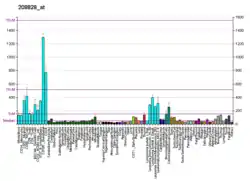POLE3
DNA polymerase epsilon subunit 3 is an enzyme that in humans is encoded by the POLE3 gene.[4][5][6]
POLE3 is a histone-fold protein that interacts with other histone-fold proteins to bind DNA in a sequence-independent manner. These histone-fold protein dimers combine within larger enzymatic complexes for DNA transcription, replication, and packaging.[supplied by OMIM][6]
References
- GRCh38: Ensembl release 89: ENSG00000148229 - Ensembl, May 2017
- "Human PubMed Reference:". National Center for Biotechnology Information, U.S. National Library of Medicine.
- "Mouse PubMed Reference:". National Center for Biotechnology Information, U.S. National Library of Medicine.
- Li Y, Pursell ZF, Linn S (Aug 2000). "Identification and cloning of two histone fold motif-containing subunits of HeLa DNA polymerase epsilon". J Biol Chem. 275 (30): 23247–52. doi:10.1074/jbc.M002548200. PMID 10801849.
- Poot RA, Dellaire G, Hulsmann BB, Grimaldi MA, Corona DF, Becker PB, Bickmore WA, Varga-Weisz PD (Oct 2000). "HuCHRAC, a human ISWI chromatin remodelling complex contains hACF1 and two novel histone-fold proteins". EMBO J. 19 (13): 3377–87. doi:10.1093/emboj/19.13.3377. PMC 313940. PMID 10880450.
- "Entrez Gene: POLE3 polymerase (DNA directed), epsilon 3 (p17 subunit)".
Further reading
- Andersson B, Wentland MA, Ricafrente JY, et al. (1996). "A "double adaptor" method for improved shotgun library construction". Anal. Biochem. 236 (1): 107–13. doi:10.1006/abio.1996.0138. PMID 8619474.
- Yu W, Andersson B, Worley KC, et al. (1997). "Large-scale concatenation cDNA sequencing". Genome Res. 7 (4): 353–8. doi:10.1101/gr.7.4.353. PMC 139146. PMID 9110174.
- Bolognese F, Imbriano C, Caretti G, Mantovani R (2000). "Cloning and characterization of the histone-fold proteins YBL1 and YCL1". Nucleic Acids Res. 28 (19): 3830–8. doi:10.1093/nar/28.19.3830. PMC 110757. PMID 11000277.
- Strausberg RL, Feingold EA, Grouse LH, et al. (2003). "Generation and initial analysis of more than 15,000 full-length human and mouse cDNA sequences". Proc. Natl. Acad. Sci. U.S.A. 99 (26): 16899–903. doi:10.1073/pnas.242603899. PMC 139241. PMID 12477932.
- Post SM, Tomkinson AE, Lee EY (2003). "The human checkpoint Rad protein Rad17 is chromatin-associated throughout the cell cycle, localizes to DNA replication sites, and interacts with DNA polymerase epsilon". Nucleic Acids Res. 31 (19): 5568–75. doi:10.1093/nar/gkg765. PMC 206465. PMID 14500819.
- Ota T, Suzuki Y, Nishikawa T, et al. (2004). "Complete sequencing and characterization of 21,243 full-length human cDNAs". Nat. Genet. 36 (1): 40–5. doi:10.1038/ng1285. PMID 14702039.
- Humphray SJ, Oliver K, Hunt AR, et al. (2004). "DNA sequence and analysis of human chromosome 9". Nature. 429 (6990): 369–74. doi:10.1038/nature02465. PMC 2734081. PMID 15164053.
- Gerhard DS, Wagner L, Feingold EA, et al. (2004). "The status, quality, and expansion of the NIH full-length cDNA project: the Mammalian Gene Collection (MGC)". Genome Res. 14 (10B): 2121–7. doi:10.1101/gr.2596504. PMC 528928. PMID 15489334.
- Rual JF, Venkatesan K, Hao T, et al. (2005). "Towards a proteome-scale map of the human protein-protein interaction network". Nature. 437 (7062): 1173–8. doi:10.1038/nature04209. PMID 16189514. S2CID 4427026.
- Olsen JV, Blagoev B, Gnad F, et al. (2006). "Global, in vivo, and site-specific phosphorylation dynamics in signaling networks". Cell. 127 (3): 635–48. doi:10.1016/j.cell.2006.09.026. PMID 17081983. S2CID 7827573.
This article is issued from Wikipedia. The text is licensed under Creative Commons - Attribution - Sharealike. Additional terms may apply for the media files.



